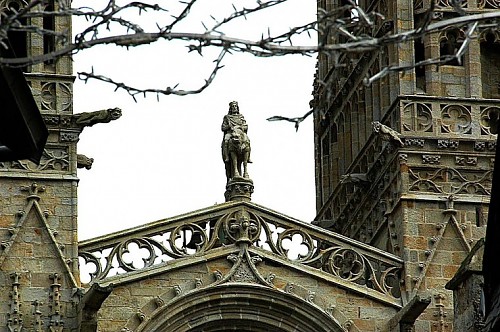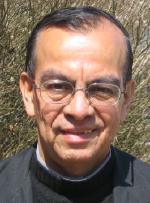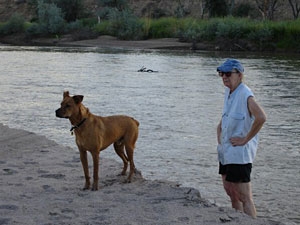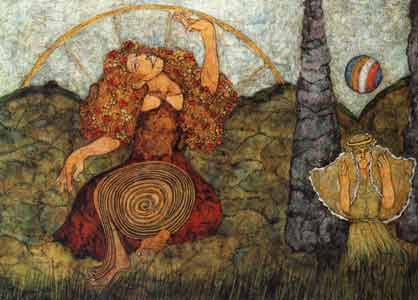A mermaid is rising in the desert. 
When complete, she will stand 25 feet tall. Through an entrance at the front of her hips one can access her interior and climb on top of her. Her scales are cut from colorful 55-gallon steel drums. Blue and green lights glow from within.
Designed by Lisa Nigro, Dahud-Ahes the Mermaid is an interactive installation in process.
A Breton princess, Dahut was the daughter of Gradlon, a king, and the sorceress Malgven. Gradlon built the beautiful city of Ys for his daughter, because Dahut loved the sea. Ys was also known as Ker-Ys in the Breton tongue.
King Gradlon was a christian, his daughter Dahut was a pagan like her mother. The king’s advisor was a monk, St. Guenole. He whispered against Dahut, and predicted her way of life would bring the downfall of the city. 
Dahut was seduced by a demon or a fairy, who took the form of a beautiful young man. As proof of her love, he asked her to open the seagate at night to let him in. She stole the key while her father slept, opened the gates, and the sea flooded in, drowning most of the people of Ys.
King Gradlon and St. Guenole were among the survivors. The king would have saved his daughter, but Guenole urged him to throw Dahut into the water. Afraid for his life, he did. The water immediately receded, but the entire city was submerged and became part of the Bay of Dourarnenez. The legend said Dahut did not die, but was transformed into a mermaid. 
Dahud-Ahes was probably the daughter of 6th c. king of Kernev, or Cornwall, with branches in Wales and Brittany. Dahud was undoubtedly a druidess adhering to the old religion, and a force against St. Gwennole (St. Guenole) who wanted to convert the entire region to Christianity.
There are many Celtic legends about lost cities. Perhaps they have their inspiration from the tale of Atlantis. Most likely the reworking of the legend of Ys by christian scribes and missionaries was to link it to Sodom and Gomorrah–what disasters can befall a town with a pagan influence and practices.
King Gradlon rode on to the city of Quimper and established it as his new capital. On the cathedral is a figure of him on his horse, looking back toward the sea at Ys. 
“Air pollution is an issue for the Olympics. The government has shut down all heavy industry within an enormous area for three months. Factories within 200 kilometers of downtown Beijing have been requested to close. Only a little production can relocate to more distant places on short notice. Severe restrictions on cars and trucks in Beijing are another drastic measure to ensure clean air. These inconvenient and costly steps tell the whole world that clean air for the Games is essential. I wish they would also realize the importance of great religious and social freedom.”
– Bishop John Tong Hon of Hong Kong 
The Catholic bishops in El Salvador put forth their stance on mining in the country a little more than a year ago in the declaration: Let’s Take Care of Everyone’s Home. It is a strong, clear statement about the dangers of precious metals mining. The burgeoning gold and silver mines are primarily operated by Canadian companies and subject only to light regulation.
“Our small country is the place where God the Creator called us to life. This is the portion of the world that he has trusted us to take care of and use according to his will: ‘Be fruitful and multiply. Fill the earth and govern it.’ (Gen 1:28). But this blessed Earth that we love so dearly, suffers an increasing and insensitive deterioration. We all have a responsibility to conserve and defend it because the environment is ‘the house of all’: it is ours and that of future generations.”
“From this perspective of faith we wish to share with you our pastoral vision on a problem that deeply worries us: the possibility that mining of precious metals is authorized, to pen cast mining or subterranean mining, mainly in the northern part of our country.”
“The experience in brother and neighboring countries, that have permitted gold and silver mining, is truly sad and lamentable. The bishops of those nations have raised their voice. We also wish to pronounce ourselves against (mining) before it is too late.”
SHARE Foundation recently sponsored a trip to the U.S. for Bishop Gregorio Rosa Chavez, auxiliary Bishop of San Salvador. Addressing a group in Kansas City, he said the mines have the potential to destroy El Salvador’s ecological system. 
“You know our country is very small,” he said. “Twenty-thousand kilometers (12,400 miles) square. Very crowded, 6 million people, or 300 people on each kilometer square. The mines are situated in the north of the country and the drinking water comes from the north. If the water is poisoned, everyone would be.”
The argument that such mining operations help the Salvadoran economy and provide jobs is fallacious, he said. “How much money remains in the country?” Bishop Chavez asked. “Two percent. There is no proportion between the profits and the damages.”
The 37th prayer listed “for special occasions” in the Catholic Sacramentary, the official Catholic worship book, is the prayer “to avert storms.” The text reads:
Father, all the elements of nature obey your command. Calm the storm that threatens us and turn our fear of your power into praise of your goodness.
When floodwaters converged on Iowa City in early June, Fr. Jeff Belger, director of the Catholic Student Center, said he started to say the prayer at daily Masses. “It was the first time in five years as a priest that I’ve had to use that prayer.”
I’m sure some people are saying it now, as Tropical Storm Fay approaches the Florida Keys. I am glad to know it, and will have it at hand, in my home out on the East End of Long Island once hurricane season gets underway.
Weather-related prayers – for rain in time of drought or protection from violent storms – are based on a concept of God as the one who controls nature. In many cultures, including our own, people expect priests and religious leaders to petition God for favorable weather, a good harvest, a safe voyage through the storm.
Some might say these prayers in times of terror and stress originate from the child within us. But a very famous scene in the Gospels – Christ rebuking the wind and calming the sea (Mark 4:37-41) – reinforces the belief God will intervene to save us, our loved ones and neighbors, our pets and property as the storm descends in fury.
If not, then to give us the strength to face what we must, and adapt with courage to the circumstances we are given, and trust that, whatever happens, we are always in God’s hands. 
As the sun rises, a slight, gray-haired woman emerges onto the worn plank porch of her house and pours a glass of water out onto the sandy soil, lifts the cup to the sun, then drinks the rest of it.
In this daily ritual, artist Meinrad Craighead rebaptizes herself, making a short prayer to God as Mother: “You have given me life. This is my daily prayer. You’re going to take care of me.”
Her work portrays in vivid color both an active visual dialogue with God and a keen sense of the brooding, watching, beckoning power she finds in the land around her, in the sky above, the earth below, in the animals, in our dreams.
Her first real religious experience, at age 7, was not in church but in nature, with her dog, she said. She had retreated from the heat of a summer day to the shade of some hydrangea bushes. Under the flowers’ blue dome, she found herself gazing into her dog’s eyes. “They were as deep, as bewildering, as unattainable as a night sky,” she said of the eyes, and as she stared she felt a rush of water coming from deep within her. 
“I listened to the sound of water inside, saw a woman’s face, and understood: This is God. Soon after this I came upon a photo in a book of a statue of a woman. The recognition was immediate, certain: I knew this was the woman I’d heard inthe water and whose face I had seen in the dog’s eyes. This discovery brought a sense of well-being and gratitude, which has never diminished. Because she was a living force within me, she was more real, more powerful than the remote ‘Father’ I was educated to have faith in.”
“God the Mother came to me and, as children will do, I kept her a secret. We hid together inside the structures of institutional Catholicism. Through half a lifetime of Catholic liturgies, during my school years, in my professional work as an educator, for 14 years in a monastery, she lived at my innermost center, the groundsill of my spirituality.” 
Read the whole, glorious article, Art and Spirituality: In the name of the mother, by Richard Heffern here.









